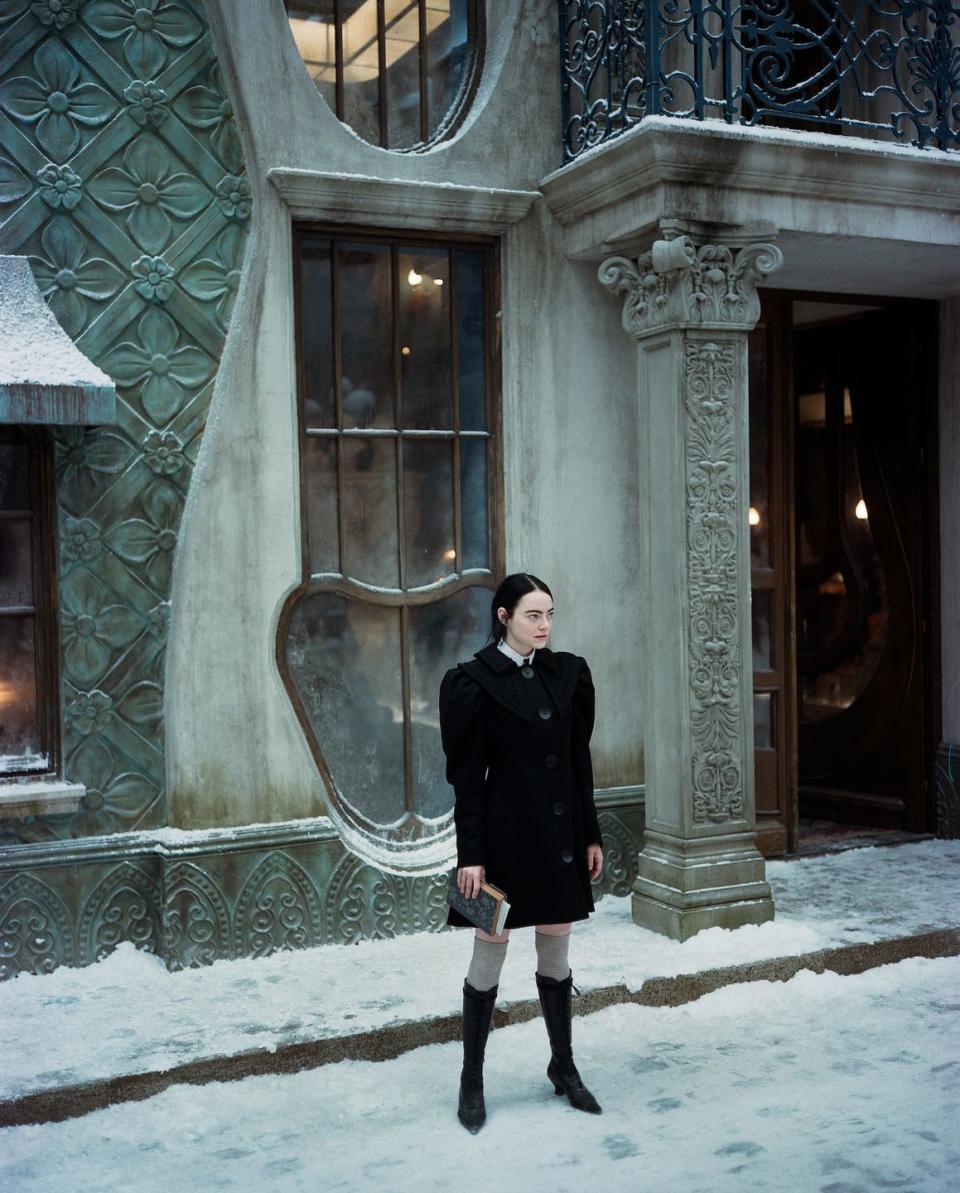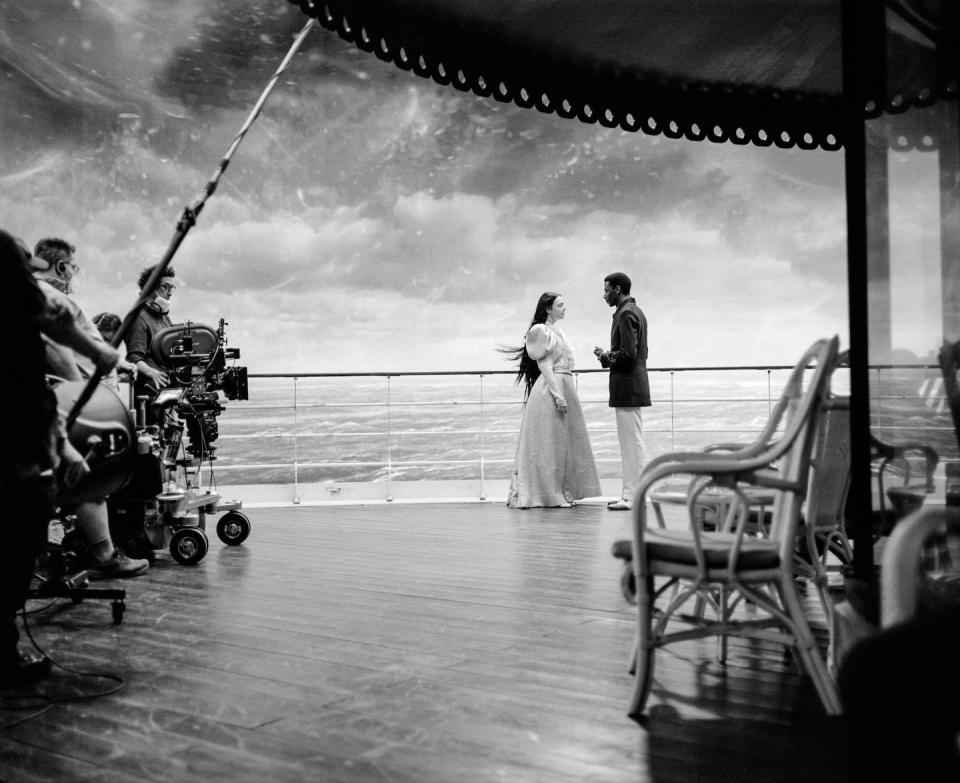I really don’t know how to describe it Poor things. In the latest film by Yorgos Lanthimos (Oscar nominees The favorite And The lobster), Emma Stone stars as Bella Baxter, a woman in Victorian London whose body has been brought back to life and implanted with the brain of a fetus – and somehow that’s the most tame and believable aspect of the film. For reasons I’ll let you discover for yourself, Bella embarks on a strange, erotic journey around the world that takes her from Portugal to Egypt and beyond. It’s part steampunk romance, part twisted black comedy coming-of-age fantasy, and something you definitely don’t want to see in the room with your parents. But if you love movies, you’ll love every minute of this intense, emotional and hilarious romp.
And of course: the clothes! We spoke with Poor things costume designer Holly Waddington to learn more about how she came up with the film’s unique look – and what it was like working with the one and only Emma Stone on this unique character.
Poor things it seems as if almost nothing preceded it. How would you describe the costumes of this film?
I think it’s a subtle shift from the late 19th century. I was freed by Yorgos to reference different time periods, so there are a few nods to different fashion moments. The little white boots that Bella is wearing are from André Courrèges’ space-age stuff from the ’60s. There was also some Schiaparelli stuff from the ’30s. It was a very vibrant palette and I feel I was able to translate the richness of the late 19th century with some freshness.
The clothing is sometimes quite unusual. There’s a scene in Lisbon where we see Bella wandering around the city alone after a siesta, wearing some sort of blazer, silk panties and not much else.
When I thought about how to approach Bella, I looked to my own children. I spend a lot of time with children in my life, and when they are very small they start to fall apart very quickly; ultimately they miss things and have some kind of innate will to be naked. I liked the idea of Mrs. Prim getting Bella ready in the morning in a ladylike skirt and bodice, but by 10am the skirt would be gone.


So it’s about Bella’s dynamic with a baby’s brain in a woman’s body.
For me, my worst nightmare would be walking down the street buttoned up from the waist down, but having nothing from the waist down. It’s a nightmare for adults, but for this character in Lisbon after a siesta, it felt good. There are certain moments when Bella dresses herself, and it’s like a five-year-old child dressing herself from her mother’s closet. It’s this dissonance, but it’s playful.
This film also makes a serious case for bringing back the leg of mutton cover.
Bella wears that all the time, or she’s completely sleeveless. Yorgos was really open to anything I might have come up with, and I presented him with a lot of ideas and options from the late 19th century, and he kept moving towards these huge sleeves. He and Emma both insisted on it in meetings. I love them, and what they do to the body. It reinforces this feeling of otherness: these highly structured fabrics that are very animalistic.


Maybe this movie will spark a trend of mutton leg sleeves?
I hope so! Big sleeves are definitely worth wearing. They are very empowering. When sleeves were big for women – the Elizabethan period, the 1940s, the 1980s – women were generally in a good place. I’m so glad we went with them. Let’s say we had gone for a skinny sleeve from the 1880s, then all the attention would have gone to the skirts and pants, and it would have felt completely different.
Bella’s clothes also look quite light and delicate.
All her fabrics are quite dreamy. There is an ease to them. But the sleeves kept tearing. It was pretty bad!
Why did they keep tearing?
It’s unusual to wear these period costumes because your protagonist doesn’t normally swing around [in a period piece]. These clothes are not designed to lift your arm above your head; they are almost an extension of the corset, holding the body in a certain way.
Bella has a very special way of walking in this film. Did you work with Emma to adjust the costumes to make her performance easier or more visible on camera?
We started her off in longer panties, like 1930s panties. And on the first day of shooting, I realized that she really needed short bloomers, to show more of her body, to show everything she was doing with her body.
It sounds like Emma has been quite collaborative working on this. Did she let you run free, or did she have a lot of influence on her costume?
She was both. She let me roam completely free. But she is also someone who needs to know conceptually whether the idea works for her. Instead of spending a lot of time trying things on to feel how things fit on the body, she was more interested in the idea behind something and why. She is a very fast, smart and very intelligent woman, so our adjustments were more like conversations. It’s interesting because other actors must have really tried something on, walked in it, felt it, so that was interesting… She’s a real firecracker of a person – fast, quick and just gets it all. She is incredibly brave and takes risks in everything she does.


What was the hardest look to get right?
The wedding dress was an absolute nightmare to make. The whole conceit was that it had to be huge, but made from almost nothing. The sleeves were like a balloon. It was super light, made from millinery, organza, cotton and tulle, and it was so tricky to make.
Was there something your actors tried to steal from the set?
It’s a bit of a moot point, because we’re currently putting together the costume displays for an exhibition at FIDM in Los Angeles, and there are quite a few things missing! I’m pretty bad at giving people costumes; that is not the intention!
What did you learn about yourself during this project?
I’m very passionate about historical clothing, and I really enjoy flipping them on their heads a bit.
This interview has been edited and condensed for clarity.
You might like it too